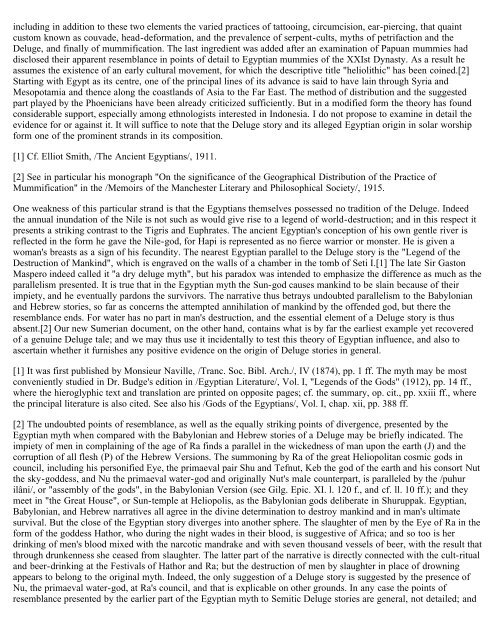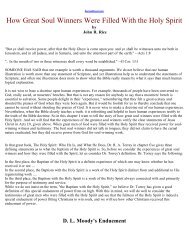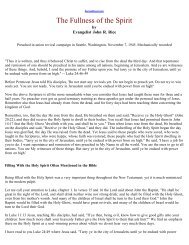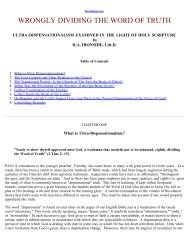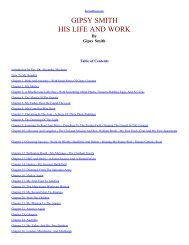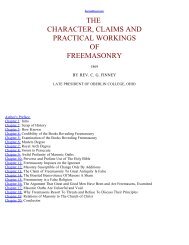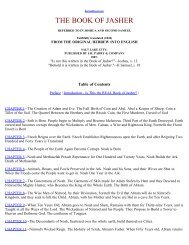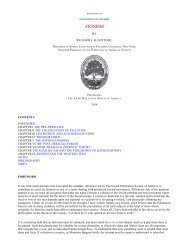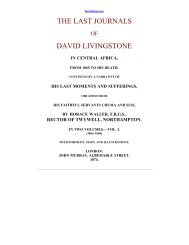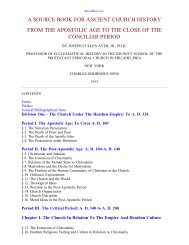Legends of Babylon and Egypt in Relation to Hebrew Tradition.pdf
Legends of Babylon and Egypt in Relation to Hebrew Tradition.pdf
Legends of Babylon and Egypt in Relation to Hebrew Tradition.pdf
Create successful ePaper yourself
Turn your PDF publications into a flip-book with our unique Google optimized e-Paper software.
<strong>in</strong>clud<strong>in</strong>g <strong>in</strong> addition <strong>to</strong> these two elements the varied practices <strong>of</strong> tat<strong>to</strong>o<strong>in</strong>g, circumcision, ear-pierc<strong>in</strong>g, that qua<strong>in</strong>t<br />
cus<strong>to</strong>m known as couvade, head-deformation, <strong>and</strong> the prevalence <strong>of</strong> serpent-cults, myths <strong>of</strong> petrifaction <strong>and</strong> the<br />
Deluge, <strong>and</strong> f<strong>in</strong>ally <strong>of</strong> mummification. The last <strong>in</strong>gredient was added after an exam<strong>in</strong>ation <strong>of</strong> Papuan mummies had<br />
disclosed their apparent resemblance <strong>in</strong> po<strong>in</strong>ts <strong>of</strong> detail <strong>to</strong> <strong>Egypt</strong>ian mummies <strong>of</strong> the XXIst Dynasty. As a result he<br />
assumes the existence <strong>of</strong> an early cultural movement, for which the descriptive title "heliolithic" has been co<strong>in</strong>ed.[2]<br />
Start<strong>in</strong>g with <strong>Egypt</strong> as its centre, one <strong>of</strong> the pr<strong>in</strong>cipal l<strong>in</strong>es <strong>of</strong> its advance is said <strong>to</strong> have la<strong>in</strong> through Syria <strong>and</strong><br />
Mesopotamia <strong>and</strong> thence along the coastl<strong>and</strong>s <strong>of</strong> Asia <strong>to</strong> the Far East. The method <strong>of</strong> distribution <strong>and</strong> the suggested<br />
part played by the Phoenicians have been already criticized sufficiently. But <strong>in</strong> a modified form the theory has found<br />
considerable support, especially among ethnologists <strong>in</strong>terested <strong>in</strong> Indonesia. I do not propose <strong>to</strong> exam<strong>in</strong>e <strong>in</strong> detail the<br />
evidence for or aga<strong>in</strong>st it. It will suffice <strong>to</strong> note that the Deluge s<strong>to</strong>ry <strong>and</strong> its alleged <strong>Egypt</strong>ian orig<strong>in</strong> <strong>in</strong> solar worship<br />
form one <strong>of</strong> the prom<strong>in</strong>ent str<strong>and</strong>s <strong>in</strong> its composition.<br />
[1] Cf. Elliot Smith, /The Ancient <strong>Egypt</strong>ians/, 1911.<br />
[2] See <strong>in</strong> particular his monograph "On the significance <strong>of</strong> the Geographical Distribution <strong>of</strong> the Practice <strong>of</strong><br />
Mummification" <strong>in</strong> the /Memoirs <strong>of</strong> the Manchester Literary <strong>and</strong> Philosophical Society/, 1915.<br />
One weakness <strong>of</strong> this particular str<strong>and</strong> is that the <strong>Egypt</strong>ians themselves possessed no tradition <strong>of</strong> the Deluge. Indeed<br />
the annual <strong>in</strong>undation <strong>of</strong> the Nile is not such as would give rise <strong>to</strong> a legend <strong>of</strong> world-destruction; <strong>and</strong> <strong>in</strong> this respect it<br />
presents a strik<strong>in</strong>g contrast <strong>to</strong> the Tigris <strong>and</strong> Euphrates. The ancient <strong>Egypt</strong>ian's conception <strong>of</strong> his own gentle river is<br />
reflected <strong>in</strong> the form he gave the Nile-god, for Hapi is represented as no fierce warrior or monster. He is given a<br />
woman's breasts as a sign <strong>of</strong> his fecundity. The nearest <strong>Egypt</strong>ian parallel <strong>to</strong> the Deluge s<strong>to</strong>ry is the "Legend <strong>of</strong> the<br />
Destruction <strong>of</strong> Mank<strong>in</strong>d", which is engraved on the walls <strong>of</strong> a chamber <strong>in</strong> the <strong>to</strong>mb <strong>of</strong> Seti I.[1] The late Sir Gas<strong>to</strong>n<br />
Maspero <strong>in</strong>deed called it "a dry deluge myth", but his paradox was <strong>in</strong>tended <strong>to</strong> emphasize the difference as much as the<br />
parallelism presented. It is true that <strong>in</strong> the <strong>Egypt</strong>ian myth the Sun-god causes mank<strong>in</strong>d <strong>to</strong> be sla<strong>in</strong> because <strong>of</strong> their<br />
impiety, <strong>and</strong> he eventually pardons the survivors. The narrative thus betrays undoubted parallelism <strong>to</strong> the <strong>Babylon</strong>ian<br />
<strong>and</strong> <strong>Hebrew</strong> s<strong>to</strong>ries, so far as concerns the attempted annihilation <strong>of</strong> mank<strong>in</strong>d by the <strong>of</strong>fended god, but there the<br />
resemblance ends. For water has no part <strong>in</strong> man's destruction, <strong>and</strong> the essential element <strong>of</strong> a Deluge s<strong>to</strong>ry is thus<br />
absent.[2] Our new Sumerian document, on the other h<strong>and</strong>, conta<strong>in</strong>s what is by far the earliest example yet recovered<br />
<strong>of</strong> a genu<strong>in</strong>e Deluge tale; <strong>and</strong> we may thus use it <strong>in</strong>cidentally <strong>to</strong> test this theory <strong>of</strong> <strong>Egypt</strong>ian <strong>in</strong>fluence, <strong>and</strong> also <strong>to</strong><br />
ascerta<strong>in</strong> whether it furnishes any positive evidence on the orig<strong>in</strong> <strong>of</strong> Deluge s<strong>to</strong>ries <strong>in</strong> general.<br />
[1] It was first published by Monsieur Naville, /Tranc. Soc. Bibl. Arch./, IV (1874), pp. 1 ff. The myth may be most<br />
conveniently studied <strong>in</strong> Dr. Budge's edition <strong>in</strong> /<strong>Egypt</strong>ian Literature/, Vol. I, "<strong>Legends</strong> <strong>of</strong> the Gods" (1912), pp. 14 ff.,<br />
where the hieroglyphic text <strong>and</strong> translation are pr<strong>in</strong>ted on opposite pages; cf. the summary, op. cit., pp. xxiii ff., where<br />
the pr<strong>in</strong>cipal literature is also cited. See also his /Gods <strong>of</strong> the <strong>Egypt</strong>ians/, Vol. I, chap. xii, pp. 388 ff.<br />
[2] The undoubted po<strong>in</strong>ts <strong>of</strong> resemblance, as well as the equally strik<strong>in</strong>g po<strong>in</strong>ts <strong>of</strong> divergence, presented by the<br />
<strong>Egypt</strong>ian myth when compared with the <strong>Babylon</strong>ian <strong>and</strong> <strong>Hebrew</strong> s<strong>to</strong>ries <strong>of</strong> a Deluge may be briefly <strong>in</strong>dicated. The<br />
impiety <strong>of</strong> men <strong>in</strong> compla<strong>in</strong><strong>in</strong>g <strong>of</strong> the age <strong>of</strong> Ra f<strong>in</strong>ds a parallel <strong>in</strong> the wickedness <strong>of</strong> man upon the earth (J) <strong>and</strong> the<br />
corruption <strong>of</strong> all flesh (P) <strong>of</strong> the <strong>Hebrew</strong> Versions. The summon<strong>in</strong>g by Ra <strong>of</strong> the great Heliopolitan cosmic gods <strong>in</strong><br />
council, <strong>in</strong>clud<strong>in</strong>g his personified Eye, the primaeval pair Shu <strong>and</strong> Tefnut, Keb the god <strong>of</strong> the earth <strong>and</strong> his consort Nut<br />
the sky-goddess, <strong>and</strong> Nu the primaeval water-god <strong>and</strong> orig<strong>in</strong>ally Nut's male counterpart, is paralleled by the /puhur<br />
ilâni/, or "assembly <strong>of</strong> the gods", <strong>in</strong> the <strong>Babylon</strong>ian Version (see Gilg. Epic. XI. l. 120 f., <strong>and</strong> cf. ll. 10 ff.); <strong>and</strong> they<br />
meet <strong>in</strong> "the Great House", or Sun-temple at Heliopolis, as the <strong>Babylon</strong>ian gods deliberate <strong>in</strong> Shuruppak. <strong>Egypt</strong>ian,<br />
<strong>Babylon</strong>ian, <strong>and</strong> <strong>Hebrew</strong> narratives all agree <strong>in</strong> the div<strong>in</strong>e determ<strong>in</strong>ation <strong>to</strong> destroy mank<strong>in</strong>d <strong>and</strong> <strong>in</strong> man's ultimate<br />
survival. But the close <strong>of</strong> the <strong>Egypt</strong>ian s<strong>to</strong>ry diverges <strong>in</strong><strong>to</strong> another sphere. The slaughter <strong>of</strong> men by the Eye <strong>of</strong> Ra <strong>in</strong> the<br />
form <strong>of</strong> the goddess Hathor, who dur<strong>in</strong>g the night wades <strong>in</strong> their blood, is suggestive <strong>of</strong> Africa; <strong>and</strong> so <strong>to</strong>o is her<br />
dr<strong>in</strong>k<strong>in</strong>g <strong>of</strong> men's blood mixed with the narcotic m<strong>and</strong>rake <strong>and</strong> with seven thous<strong>and</strong> vessels <strong>of</strong> beer, with the result that<br />
through drunkenness she ceased from slaughter. The latter part <strong>of</strong> the narrative is directly connected with the cult-ritual<br />
<strong>and</strong> beer-dr<strong>in</strong>k<strong>in</strong>g at the Festivals <strong>of</strong> Hathor <strong>and</strong> Ra; but the destruction <strong>of</strong> men by slaughter <strong>in</strong> place <strong>of</strong> drown<strong>in</strong>g<br />
appears <strong>to</strong> belong <strong>to</strong> the orig<strong>in</strong>al myth. Indeed, the only suggestion <strong>of</strong> a Deluge s<strong>to</strong>ry is suggested by the presence <strong>of</strong><br />
Nu, the primaeval water-god, at Ra's council, <strong>and</strong> that is explicable on other grounds. In any case the po<strong>in</strong>ts <strong>of</strong><br />
resemblance presented by the earlier part <strong>of</strong> the <strong>Egypt</strong>ian myth <strong>to</strong> Semitic Deluge s<strong>to</strong>ries are general, not detailed; <strong>and</strong>


